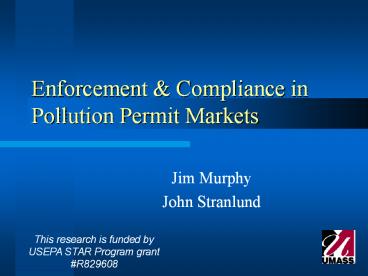Enforcement - PowerPoint PPT Presentation
1 / 14
Title: Enforcement
1
Enforcement Compliance inPollution Permit
Markets
- Jim Murphy
- John Stranlund
This research is funded by USEPA STAR Program
grant R829608
2
Motivation
- Environmental regulations often involve fixed
standards - Emissions standards
- Technology standards
- Market-based mechanisms can meet environmental
goals at lower cost - Programs must be enforced well
3
Enforcing markets different than standards
- Regulators have experience enforcing emissions
standards - e.g., Target enforcement at firms with high
abatement costs or low standards - Enforcing market-based mechanisms fundamentally
different - Permit price is key determinant of compliance
- Require new types of enforcement strategies
Policy implication Enforcement strategies that
were effective for standards might not be
appropriate for markets
4
Implications for enforcement of permit markets
- Violations depend on
- Permit price and enforcement
- ? violations independent of firm characteristics
- e.g., abatement costs, initial permit allocation
- ? no justification for targeted enforcement
- Compliance decisions are linked together through
the permit market - Direct effects and indirect price effects
5
Direct and indirect price effects
- Effects of increased enforcement on
- Violations
- a negative direct effect
- a countervailing positive price effect
- Two steps forward, one step back
- Emissions
- no direct effect
- only a negative price effect
Policy implication Changes in enforcement can
induce changes in permit priceswhich affect
compliance decisions.
Policy implication To improve environmental
quality, enforcement must be broad enough to
affect permit price.
6
Nice story, but wheres the proof?
- Well-developed theory about compliance and
enforcement of permit markets - Theory has important implications for design of
enforcement strategies - Butthere are no direct empirical tests of the
theory - Lab experiments allow us to test theory in a
controlled setting - Wind tunnel
7
Theoretical framework
- Theoretical model
- Firms maximize expected profits by choosing
- Emissions
- Permits
- Parameters
- Firm abatement costs
- Enforcement Audit probability Fine
- Aggregate standard
- Initial permit allocation
? Violations
8
Experimental design
Each cell repeated 3 times with 8 participants
per group.
9
Experiment details
- Subjects
- UMass students
- 2-hour training before real data sessions
- Paid 7 for show-up, plus experiment earnings
- (avg 14).
- 8 subjects per group, 4 of each type
- Type-A High marginal abatement cost
- Type-B Low marginal abatement cost
- 12 identical 5-minute periods
- Discarded first 2 periods
10
Experiment details
- Production (emissions)
- Generates Earnings from Production
- Each unit produced sequentially
- Only during first 4 minutes of period
- Permit market
- Continuous double auction
- Trading allowed for full 5 minutes of period
- Random audits and penalties if necessary after
period ends
11
Results Targeted enforcement
- Violations
- Independent of marginal abatement costs
- NOT independent of initial permit allocation
- Permit buyers tend toward higher violations
- Responsiveness to enforcement
- Independent of marginal abatement costs
- Independent of initial permit allocation
Policy implication With markets, little support
for targeted enforcement
12
Results Contrast with emissions standards
- Violations
- Depend upon firm characteristics
- High marginal abatement costs and/or low standard
yield greater violations - Responsiveness to enforcement
- Greater for firms with high marginal abatement
costs
Policy implication With standards, firm-level
characteristics are important determinants of
compliance and effectiveness of enforcement. Not
true with markets.
13
Results Direct and indirect price effects
- Strong support for hypotheses about indirect
price effects of enforcement - Violations Countervailing positive price effect
- Emissions No direct effect, only indirect price
effect
Policy implication Impacts of increased
enforcement could be overstated
Policy implication To improve environmental
quality, enforcement must be broad enough to
affect permit price.
14
Concluding remarks
- Enforcing permit programs is fundamentally
different from emissions standards - Experiment results largely consistent with theory
- Targeted enforcement
- Little justification under emissions trading
- Requires competitive trading by risk neutral
firms. - Direct and indirect effects of enforcement
- Permit programs ? permit price links compliance
and emissions decisions. - Standards ? compliance decisions are independent.

